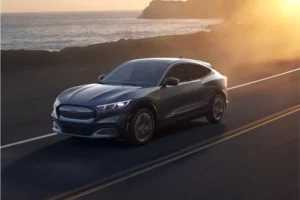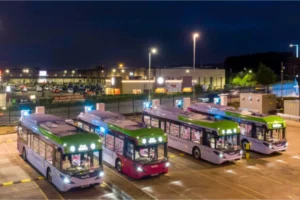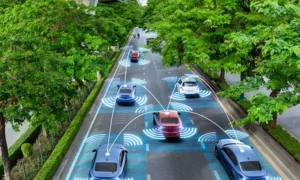The development and implementation of smart motorways will continue but there 18 key recommendations for the future including abolishing dynamic hard-shoulders, increasing the deployment of Stopped Vehicle Detection and an immediate review of emergency refuge provision.
The move comes as part of the DfT’s Smart Motorway Safety Review, which has been published today. Transport Secretary, Grant Shapps, has set out the 18 point package of measures to improve safety and public confidence, including a £5million programme to communicate with the general public.
The ‘action-plan’ is to ensure smart motorways are as safe as possible and work will focus on getting help to broken down drivers much quicker and making the schemes less confusing.
This follows analysis commissioned by the Transport Secretary which found that overall, evidence shows that in most ways smart motorways are as safe as, or safer than, conventional ones. Data shows that the risks that are lower on smart motorways compared with conventional motorways include tailgating, rapid changes of vehicle speeds, vehicles drifting off the carriageway and vehicles being driven too fast. However, some risks are higher than on conventional motorways, for example the risk of a collision between a moving and stationary vehicle.
In a statement, Grant Shapps said: “Following concerns about smart motorway safety, I asked my department to review the evidence and, if needed, bring forward recommendations. I am publishing that work and taking the action necessary to ensure our roads are as safe as they can be.
“Overall, what the evidence shows is that in most ways, smart motorways are as safe as, or safer than, the conventional ones. But not in every way. To ensure we are doing all we can do to improve safety, I am publishing a package of 18 measures. This will allow us to retain the benefits of smart motorways while addressing the concerns that have been identified.˜Smart motorways have helped us cope with a 23 percent rise in traffic since 2000. They save motorists thousands of hours sitting in jams. They reduce the disruption and environmental destruction which would otherwise be needed to widen our busiest roads. Their growth, however, has not always been well explained, there is not uniformity, and concerns exist over safety.”
The key recommendations include:
*Abolishing the confusing “dynamic hard shoulder†smart motorways, where the hard shoulder operates only part-time and is a live running lane the rest of the time
*Substantially speeding up the deployment of stopped vehicle detection technology across the entire “all lane running†smart motorway network, so stopped vehicles can be detected and the lanes closed more quickly. Highways England is to accelerate its plans and install the technology within the next 36 months, setting a clear public timetable for the first time
*Faster attendance by more Highways England traffic officer patrols on smart motorways where the existing spacing between places to stop in an emergency is more than one mile, with the aim of reducing the attendance time from an average of 17 minutes to 10 minutes
*Reducing the distance between places to stop in an emergency to three quarters of a mile where feasible so that on future schemes motorists should typically reach one every 45 seconds at 60mph. The maximum spacing will be 1 mile
*Installing 10 additional emergency areas on the existing M25 smart motorways on the section of smart motorway with a higher rate of live lane stops and where places to stop in an emergency are furthest apart
*Considering a national programme to install more emergency areas where places to stop in an emergency are more than one mile apart
*Investigating M6 Bromford viaduct and the M1 at Luton, Sheffield and Wakefield where there is evidence of clusters of incidents. Where an intervention is considered likely to make a difference, we will look to make changes at these locations
*Making emergency areas more visible. All emergency areas will have a bright orange road surface, dotted lines on the surfacing showing where to stop, better and more frequent signs on approach and signs inside giving information on what to do in an emergency. These will be installed by the end of spring 2020
*More traffic signs giving the distance to the next place to stop in an emergency, so you will almost always be able to see a sign. Typically, these will be between approximately 330 and 440 yards apart
*More communication with drivers. We recognise that we could do more therefore we are committing to an additional £5m on national targeted communications campaigns to further increase awareness and understanding of smart motorways, how they work and how to use them confidently
*Displaying ‘report of obstruction’ messages automatically on electronic signs, triggered by the stopped vehicle detection system, to warn drivers of a stopped vehicle ahead, this is currently being trialled on the M25 and then a further trial on the M3
*Places to stop in an emergency shown on your satnav by working with satnav providers to ensure the locations are shown on the screen, when needed
*Making it easier to call for help if broken down by working with car manufacturers to improve awareness of the use of the eCall SOS button in newer cars to call for help
*Changing the law to enable automatic detection of ‘red’ violations and enforcement using cameras and we will be expanding the upgrade of smart motorway cameras (HADECS) to identify more of those who currently ignore the ‘red x’. The penalty is 3 points on the driver’s licence and a £100 fine, or the driver can be referred to an awareness course
*An update of the Highway Code to provide more guidance
*Closer working with the recovery industry on training and procedures
*Reviewing existing emergency areas where the width is less than the current 15 foot wide standard. If feasible and appropriate we will widen to this standard
*A review of the use of red flashing lights to commence immediately. We have listened to the calls for recovery vehicles to be allowed to use red flashing lights. We will commence work immediately on a review.





















